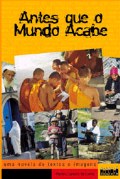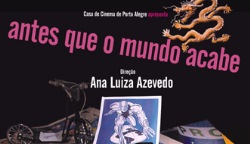|
ANTES QUE O MUNDO ACABE
(Before the world ends) a feature film by Ana Luiza Azevedo screenplay by Paulo Halm and Ana Luiza Azevedo to be shot in 2007 |
SYNOPSIS
Before the World Ends tells the story of Daniel, a fifteen-year-old
boy who lives in his own small world, facing his apparently insoluble
issues: a girlfriend who doesn’t know what she wants, a friend who is
accused of stealing, and a small town that will have to be left behind.
Everything happens when he receives a letter from his father,
who he has never met and didn’t even remember. Through the letters and
photographs sent by his father, Daniel finds out that the world is much
bigger than the one he used to know. Maria Clara, Daniel’s little
sister, watches everything going on around her and, with a critical
view, narrates this story. A story in which everything seems to be
about to end: the black bears, the orange juice, the polyandric tribes
and the peaceful life in São Pedro do Sul.
THE BOOK
 Before
the World Ends, based on the novel of the same title by Marcelo Carneiro
da Cunha, is a narrative project that combines text and photos in an experience
that offers the reader a vision of different cultures of the world, to
stimulate the reader to make a reflection on diversity and on his/her reality.
Before
the World Ends, based on the novel of the same title by Marcelo Carneiro
da Cunha, is a narrative project that combines text and photos in an experience
that offers the reader a vision of different cultures of the world, to
stimulate the reader to make a reflection on diversity and on his/her reality.
The book proposes to the reader an exercise in the most revealing and critical of human actions: an alert and informed look upon the world. Through this awakened look, we will make readings of the immediate reality and a perception of other realities that make up our world.
The book is constructed in an epistolary structure. However, in order not to be bound by the traditional epistolary dialog, the book adds images to the dialog in the shape of photographs that are exchanged alongside the letters, and it also has, as a narrative support, the life of Daniel, the protagonist and the elements that constitute it.
Also, as other elements in the composition of the narrative project
that constructed this book, we have the personal history of its narrator,
Daniel, a sixteen year-old boy, living in a large Brazilian city, his friend,
his girlfriend, his parents. It is an understandable, complex, human reality,
which serves as an affective basis for the construction of the broader
narrative. The book was developed and released in 2000. It was awarded
with the Highly Recommended seal of the Fundação Nacional
do Livro Infanto-Juvenil (National Foundation of Books for Children and
Youth), and it is already in its 4th edition.
THE FILM
 A
middle/upper middle class teenager, Daniel, lives in a big Brazilian city.
He lives with his mother and her husband. He never knew his biological
father. He has a girlfriend, Mim, but the relationship that does not give
him a sense of security. Mim is an independent girl, she has her own plans,
her band, and she does not know if she wants a more stable relationship.
Daniel's best friend at school is a problem kid, Lucas. Lucas had been
an orphan in the care of a state's orphanage, and was adopted by a lower
middle class couple, and he studies in the same school as Daniel through
a scholarship program for low-income pupils. When the story begins, Lucas
is the main suspect of a robbery that has taken place in the school.
A
middle/upper middle class teenager, Daniel, lives in a big Brazilian city.
He lives with his mother and her husband. He never knew his biological
father. He has a girlfriend, Mim, but the relationship that does not give
him a sense of security. Mim is an independent girl, she has her own plans,
her band, and she does not know if she wants a more stable relationship.
Daniel's best friend at school is a problem kid, Lucas. Lucas had been
an orphan in the care of a state's orphanage, and was adopted by a lower
middle class couple, and he studies in the same school as Daniel through
a scholarship program for low-income pupils. When the story begins, Lucas
is the main suspect of a robbery that has taken place in the school.
Facing these personal issues, which already seem to constitute a sufficiently complicated situation, Daniel finds something new, a new problem: when he arrives home after having visited Lucas to give him his support, he finds the family gathered together, waiting for him, and an envelope on the dining room table. The envelope is from the father he has never met. The envelope on the table is a new and unknown factor to be faced by Daniel. Another, new and bigger problem is added to all the other problems he already is faced with.
After an initial resistance, Daniel understands that he needs to react to this new challenge, and reads what his father has to say. He discovers that his father is a photographer, who sends him letters and photos. He learns of the reasons that led his father to stay away from the family, he learns that his father had been a war correspondent, and that he now belongs to an international organization called Before the World Ends. This organization is devoted to recording and documenting different cultures of the world that are under threat of extinction under the impact of fast globalization.
The letters from Daniel's father explain to the son he does not know the reasons for his existence. While he is introducing himself to his son, the father is also justifying himself to his son and to the world. After a long period of indecision about what to do, the son begins to answer his father's letters, through photographs. Daniel begins to look around him. This look gives way to a more intense perception of the world around him. He transforms this look into photographs, which he sends to his father, and thus the dialog between them develops, from the photos taken by each one of them, which show their realities.
Meanwhile, the crises in Daniel's world intensify. Lucas is expelled from school because of what he is believed to have done. Mim, his girlfriend, tells him she does not want a relationship anymore, she wants to be totally independent.
And, in the midst of all these issues, Daniel is required to make his
first adult choices, now more alert, more aware and critical of the world
around him.
THE CASA | FILMS | PROJECTS | NEWS | CONTACT | HOME | EM PORTUGUÊS | EN ESPAÑOL
